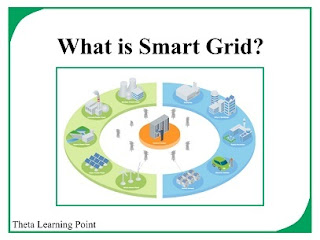Electric Grid
An interconnected network of different components of a power
system like generating stations, transmission stations, distribution stations,
consumer loads, etc. which is designed to deliver the electrical energy
produced by the utility companies to the consumers is known as an electric grid.
A typical electric grid consists of power generating plants,
electrical substations, electric power transmission and distribution systems and
consumer electric loads. The part of an electric grid which is the
combination of transmission and distribution system is known as the power grid or grid or national grid.
Based on the technology used, the electric grid may be
broadly classified into two major types namely:
- Conventional Grid
- Smart Grid
Where a conventional
grid is a type of electric grid which provides only a one-way flow of
electrical energy, and there is no mechanism for obtaining feedback from the
consumers. Hence, the conventional grid is a less efficient and less reliable form
of the electric grid.
What is Smart Grid?
A smart grid is a modernized form of an existing electric grid, which consists of smart energy meters, advanced technology and two-way digital communication to fulfil the energy demand with good power quality.
In actual practice, every country and any technological
platform gives a different definition of a smart grid in the way they
individually use it. But, according to Electric
Power Research Institute (EPRI), the smart grid can be defined as follows:
“The smart grid
is defined as the modernization of an electricity delivery system which
monitors, protects and automatically optimizes the operation of its interconnected
elements like the central and distributed electric generators, the transmission
networks and distribution systems, industrial users, building automation systems,
energy storage installations and end-user consumers.”
The smart grids are designed to provide benefits and remove
the barriers to organizational thinking.
Now, we can define the smart grid, in simple terms, as the transparent,
seamless and instantaneous delivery of electrical energy and information which enables
the electricity industry to better manage energy delivery and transmission. Thus,
the smart grid empowers consumers to have more control over energy
decisions.
The smart grids use the features of advanced communications
and information technologies to deliver real-time information and enable the
nearly instantaneous balance of supply and demand on the electric grid.
If we compare the conventional grid and smart grid, we found
the most significant difference that is the smart grid provides a two-way
flow of information between consumers and the grid, while the conventional grid
provides only a one-way flow of electricity. Hence, the smart grid simply means computerizing the electric grid.
The smart grid includes adding two-way digital communication
technologies to the devices associated with the electric grid. Therefore, every
device in the smart grid is equipped with sensors (power meters, voltage
sensors, fault detectors, etc.) to gather data and information in addition to
the two-way digital communication between the devices in the field and the
utility’s network operation centres.
The most significant feature of the smart grid is the
automation technologies which enables the utility to adjust and control each
individual device or several devices from a central location.
Needs of Smart Grid
The development of smart grids is required because the
currently existing design of the power grid is not suitable for meeting the future
power demand. The existing electric grid system is not enough to meet future
demand because of the following factors:
- High line losses
- Increasing fuel costs
- Limited conventional fuel availability
- Emission of greenhouse gases and other pollutants
- Regulatory concerns and government mandates
- One-way communication, i.e. no consumer involvement in power delivery
- Limited upgrading possibilities due to the complicated system
- Limited use of advanced technologies, etc.
Thus, a smart grid is one of the solutions in each and every
aspect as compared to the existing electric grid. It is because, the smart
grids are embedded with intelligent sensors and control systems, automated
smart switches, substations and robust communication technologies. As a result, smart grids can integrate all types of electric generation and
storage systems, preclude power outages and surges to a degree that is not
possible in the existing electric grid system and many other unimaginable
advancements.
Benefits of Smart Grid
As we can observe from the above discussion that the smart
grid has several benefits and advantages over the conventional grid. According
to the National Institute of Standards
and Technologies (NIST), the following are the major benefits of smart
grids:
- Smart grids improve power reliability and quality.
- Smart grids enhance the capacity and efficiency of the existing electric grids.
- Smart grids minimize the requirement of constructing peak load (or backup) power plants.
- Smart grids improve resilience to disruption and are self-healing.
- Smart grids expand the deployment (spreading) of renewable and distributed energy sources.
- Smart grids reduce oil consumption and the emission of greenhouse gases.
- Smart grids automate the operation and maintenance of power systems.
- Smart grids increase the consumer’s choice, etc.
Conclusion
Hence, in this article, we have discussed the electric grid, smart electric grid, needs and benefits of a smart grid. From the above discussion, we may conclude that the smart grid is a computerized electricity delivery scheme which allows the flow of electricity and information in both directions between the consumers and the utility.


.png)





0 Comments